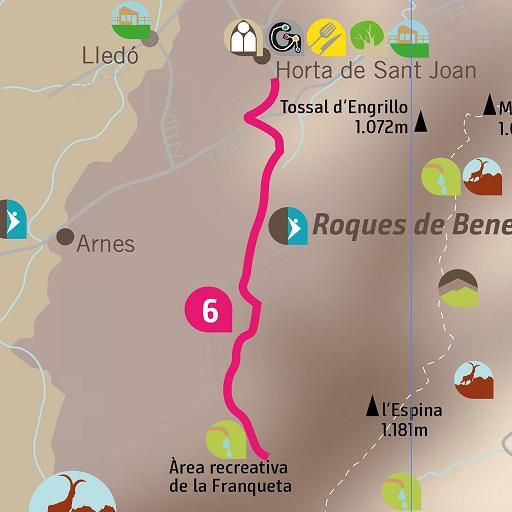Route 6. From Horta de Sant Joan to La Franqueta
Departure point: outskirts of Horta de Sant Joan
Duration: full day
Route by car: 10,3 km
Route on foot: 100 m
Circular: no
Starting on the T-333 road at the crossroads that leads to Horta de Sant Joan, we begin this route following the signs to "Els Ports". You can make a first stop at the viewpoint of "El Salt de Ferrassó", which has spectacular views of the valley and the Roques de Benet (rock formation). In this area typical of olive trees you can hear species such as the woodlark, red-legged partridge or cirl bunting. If your visit coincides with the fruiting season in the fields, you can see birds such as lesser whitethroats, song thrushes, robins or black redstarts taking advantage of the energy generated by eating olives. Continue entering the forest on the track, towards La Franqueta recreation area. Check out the birds of prey flying over the cliffs. You can see griffon vultures, Egyptian vultures and possibly some eagles such as short-toed, golden or Bonelli's eagles.
From Lliberós car park you can take a short walk to the river. Among the trees, birds such as the firecrest, crested tit and Bonelli's warbler can be observed. Search the rocky walls for the peregrine falcon, rock sparrow, blue rock thrush, crag martin, alpine swift and some ibex. If you make the visit early enough, you have a good chance of observing them before they jump up to the highest, most inaccessible parts, or look for shade in the summer heat.
From Lliberós, continue along the track, crossing areas of forests following the Vall d'Uixó ravine; there are a good number of forest birds and those typical of a Mediterranean environment such as the Dartford warbler, coal tit or red crossbill. This track takes us to La Franqueta recreation area, located in the middle of a riverside forest where great spotted woodpecker, green woodpecker and nuthatch live. In the shade of the poplars we await the visit of the most trusting birds. At the river the grey wagtail is a frequent visitor, and with luck you may see an otter.
Phenology:
We recommend doing this route between November and February if the main objective is observing birds that do not come from the high mountains, such as the alpine accentor or the wallcreeper. To see eagles, vultures and goats, any month of the year is a good choice.
Track GPX
We also make the route file available to you in gpx format so that you can use it with your GPS device (see link in the header).






